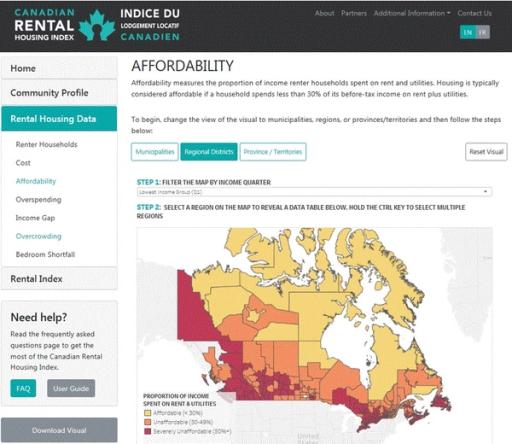August 3, 2018
2018 Canadian Rental Housing Index

Jennifer Allford for Alberta Real Estate Foundation
A new and improved Canadian Rental Housing Index (RHI) is giving policy makers, real estate professionals and other interested Canadians a clearer picture of rental markets and the state of affordable housing across the country. The RHI is a comprehensive database that compiles rental housing statistics for cities, regions, and provinces across Canada. See how much rent Canadians are paying in different parts of the country, compare affordability measures and find out where residents are overcrowded and severely overspending on housing.
The interactive web-map, which was updated in May 2018, incorporates new and comprehensive information from the 2016 long-form census. The RHI includes the latest data on rents, incomes and overcrowding in hundreds of large and small communities across Canada.
“It’s Canada’s most comprehensive database of rental housing statistics and provides information about more than 800 municipalities and regions across the country,” says Brian Clifford, the policy manager at the BC Non-Profit Housing Association (BCNPHA). The organization helped start the Rental Housing Index in BC in 2014 and worked with a number of partners across Canada to develop a national version of the RHI in 2015.
The 2018 index is easier to use than the previous website and lets people compare a number of different communities at once. “You can get a snapshot of housing information of one location and use the comparison tool to select several communities at the same time,” says Clifford. “The data can be used to understand average rents, incomes and housing stock in your community as well inform long-term housing planning, development, and research.”
The 2018 update generated a lot of media interest with stories running in major news outlets across the country—some of those stories addressed the state of rental housing in different communities. The long term goal of the RHI is to help with decision-making and planning for affordable rental housing. “We’ve seen many examples of housing stakeholders and organizations using the index to inform planning and we’re beginning to see the new data be translated into policy and research,” says Clifford.
The real estate and development industries are also using the index. The Canadian Centre for Economic Analysis, for example, used the data to compile a report for the construction industry on shelter affordability. Various industry real estate agents and blogs, including the Real Estate Management Industry network, have written about the updated RHI. “These examples provide some concrete evidence for how the index is being used by the real estate industry but we would like to see an even greater adoption of the tool within the sector,” says Clifford.
Detailed data tables can break down renter households according to income quartiles and bedroom size. This gives the user “a nuanced understanding” of where housing need is clustered and allows them to assess factors such as average rent, households spending more than half of their income on shelter costs and overcrowding across different income and bedroom sizes. “These data can help the real estate industry identify opportunities for where housing need lies, what local income ranges are, and how much housing needs to be built in specific communities,” he says.


